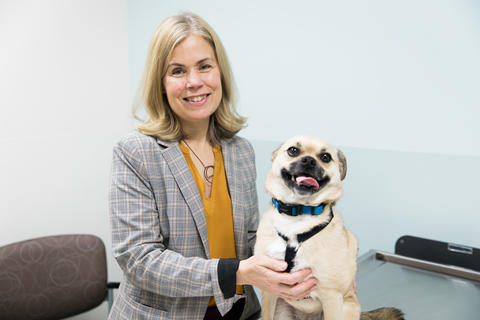
Access to Care for Pets

Many people love their pets but aren’t able to care for them the way they would like. It is estimated that 40 million pets nationwide do not get regular medical care. The reason often comes down to a lack of nearby, affordable veterinary care, and it’s a serious problem, particularly in under-resourced communities. While limited help is available, much more is needed, and the University of Minnesota is working to increase partnerships with the community to address that need.
The University's College of Veterinary Medicine has two student-led organizations that partner with communities across the state to provide care to pets and provide DVM students with learning opportunities. Vet students working with the Student Initiative for Reservation Veterinary Services (SIRVS) are able to practice providing care in a pop-up clinic setting, providing vet services to native communities within the Leech Lake, White Earth, Lower Sioux, and Mille Lacs reservation areas in greater Minnesota. Another non-profit veterinary student organization, Veterinary Treatment Outreach for Urban Community Health (VeTOUCH), pairs students with licensed veterinarians and vet technicians to provide basic pet care and nutritional support services once a month to people who are low-income and/or homeless in the Twin Cities.
Committed to providing more free and low-cost care, as well as service-learning opportunities for students, the College of Veterinary Medicine has recently invested in additional community partnerships and exploring new ways to deliver care. One of those partners may someday be the University’s Urban Research and Outreach-Engagement Center (UROC). While several ideas are being considered, the first to roll out may be a mobile vet clinic.
Based out of UROC’s parking lot, the clinic would offer health care to qualifying northside residents. Staffed by vet students working with licensed veterinarians and vet technicians, the clinic would offer checkups, vaccines and other basic services that can help keep pets healthy while easing their owners’ minds. “We are committed to preparing our students through real-world learning opportunities that will provide them with valuable experiences while also reaching underserved pets with needed medical care,” says Laura Molgaard, interim dean of the University’s College of Veterinary Medicine.
In addition to a potential UROC partnership, the College of Veterinary Medicine is also interested in partnering with the Community-University Health Care Center in the Phillips neighborhood in Minneapolis.
The CVM has been working with the Animal Humane Society, which has purchased a building in St. Paul’s Frogtown neighborhood in order to provide the community with affordable companion animal care and resources, including a pet food shelf. A CVM veterinarian will work alongside the AHS’s staff and doctors to see patients at a slower pace so they may supervise and teach vet students from the University.
“At the CVM, our mission is to improve the health and well-being of animals and people,” says Molgaard. “We are really excited to work with UROC and the Animal Humane Society in these new partnerships to give our students opportunities while reaching pets and families in need of veterinary care.”